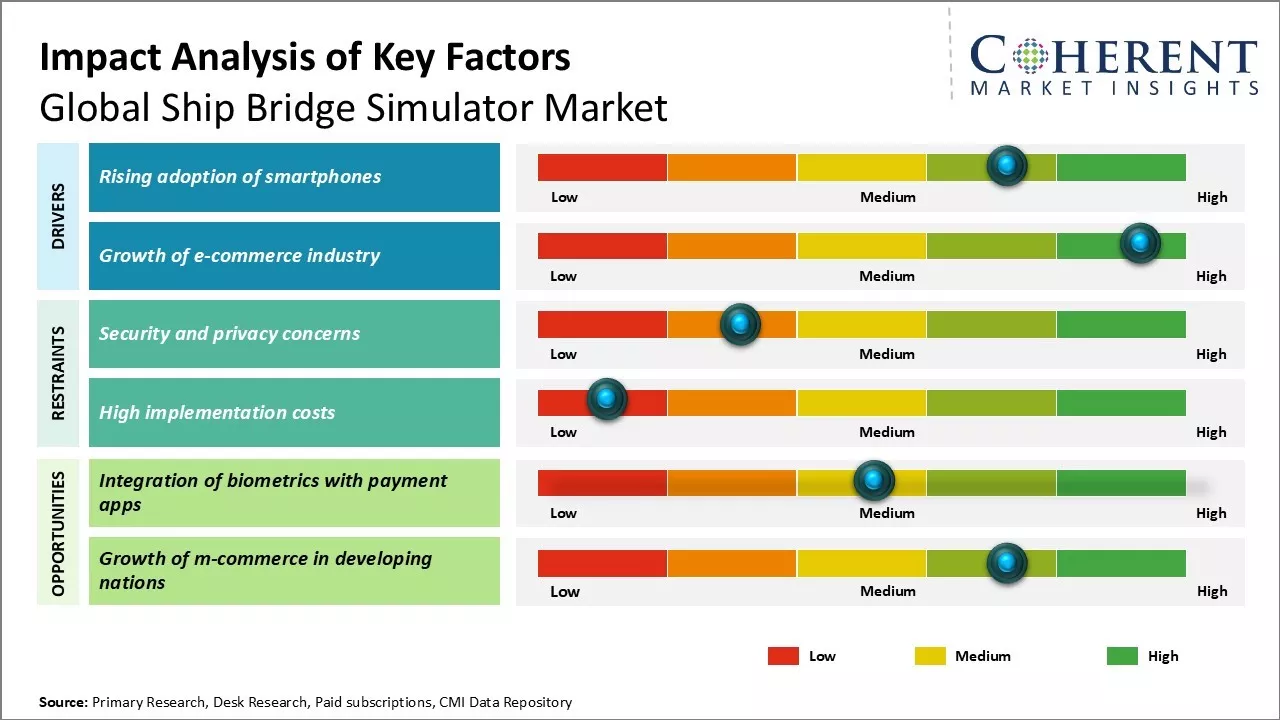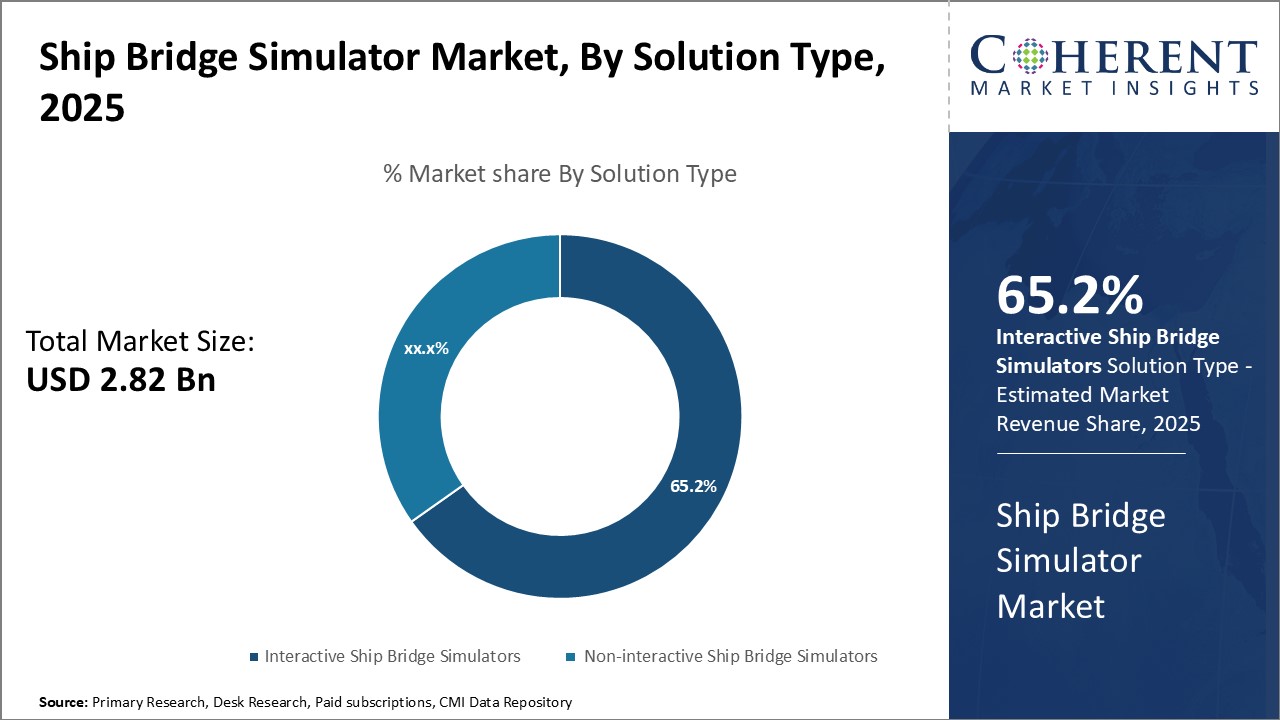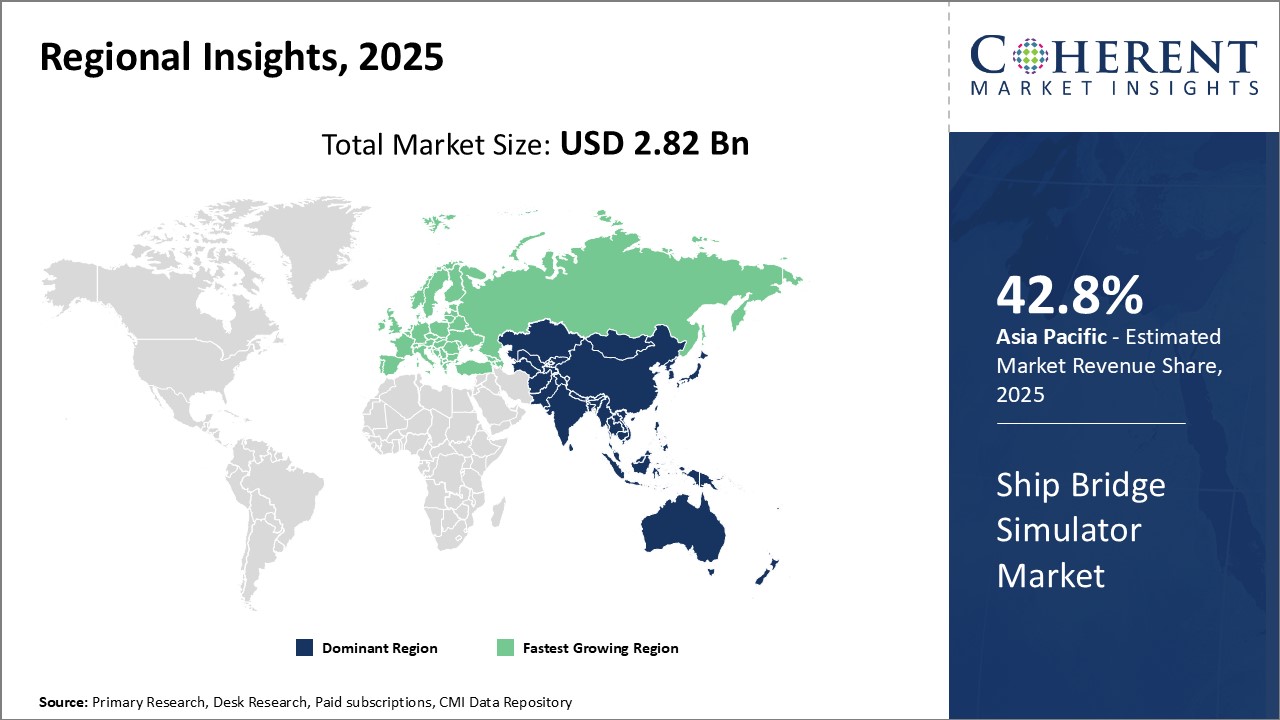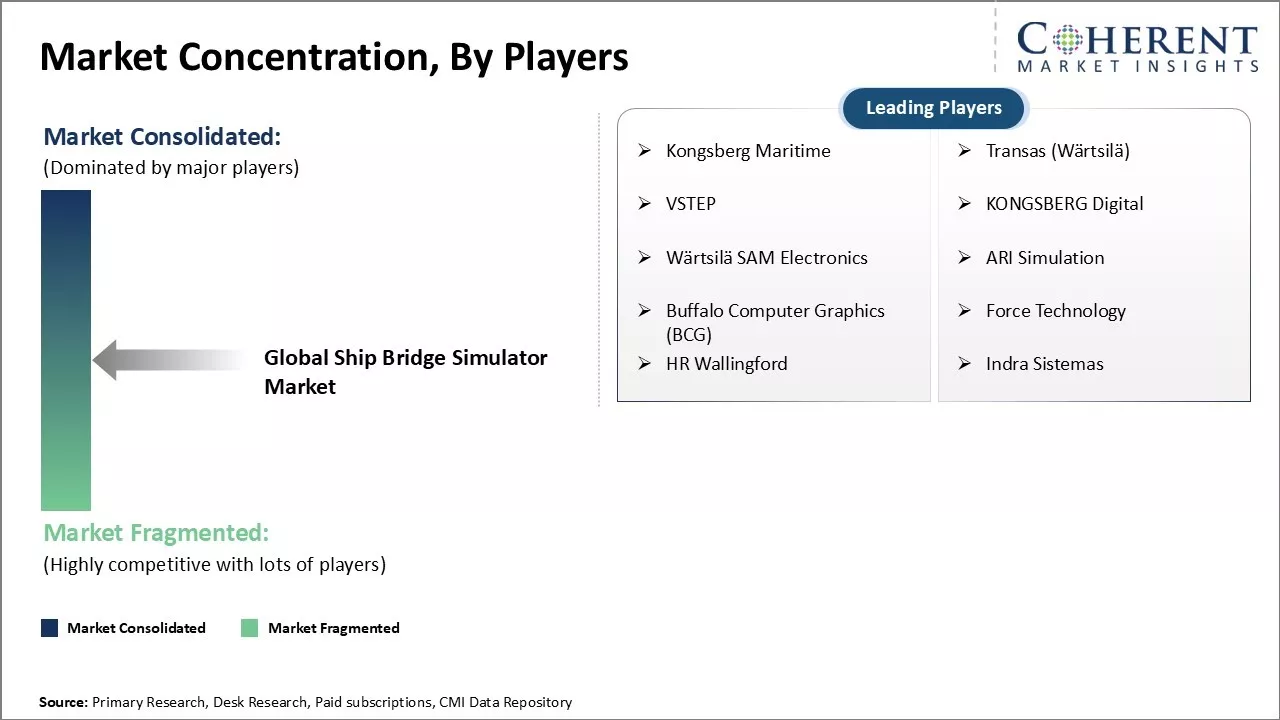Ship Bridge Simulator Market Size and Trends
Global ship bridge simulator market is estimated to be valued at USD 2.82 Billion in 2025 and is expected to reach USD 4.68 Billion by 2032, exhibiting a compound annual growth rate (CAGR) of 7.5% from 2025 to 2032.

Discover market dynamics shaping the industry: Download Free Sample
The growing demand for advanced training systems from the shipping industry and the increasing adoption of virtual simulation systems for training purposes are expected to drive the market during the forecast period.

Discover high revenue pocket segments and roadmap to it: Download Free Sample
Insights by Solution Type, Interactive Ship Bridge Simulators contributes the highest share of the market owning to its ability to deliver highly immersive training experience
In the terms of solution type, interactive ship bridge segment is estimated to hold the highest share of the market of 65.2% in 2025 due to their ability to deliver highly immersive training experience for sailors and ships' crew. These advanced simulation systems mimic real life ship operations and environments with high-fidelity visual and motion feedback. Trainees get to experience real-time decision-making scenarios under various conditions like dynamic weather, ship maneuvers, and maritime traffic situations. This helps sailors gain valuable hands-on experience without any risk to the actual vessels.
Insights by End-use Industry, Marine contributes the highest share of the market owing to stringent training mandates for seafarers
In the terms of end-use industry, marine segment is estimated to hold the highest share of the market of 63% in 2025 owing to stringent training mandates set by international maritime regulatory bodies for seafarers. International organizations like International Maritime Organization (IMO) and International Convention on Standards of Training, Certification and Watch keeping for Seafarers (STCW) have established minimum competency requirements and certification programs that must be met by maritime crew and officers working on commercial vessels.
Regional Insights

Need a Different Region or Segment? Download Free Sample
Regional Analysis: Global Ship Bridge Simulator Market
Dominating Region: Asia Pacific
Asia Pacific is expected to account for the greatest revenue share, with 42.8% in 2025. Asia Pacific region exhibits the fastest growth, driven by the increasing maritime trade within the region along with an expanding domestic commercial fleet. Countries like China, Japan and South Korea are major shipping and shipbuilding hubs.
Fastest Growing Region: Europe
Several European countries like Germany, U.K. have historically strong maritime economies with a large commercial fleet and a strong emphasis on standards and crew training. This has driven early adoption and continued usage of bridge simulators. Countries like Norway, Netherlands and Germany are global leaders in ship management and crew training.
Ship Bridge Simulator Market Outlook for Key Regions
U.S. - Global ship bridge simulator market in U.S. is driven by commitments to crew preparedness and regulatory requirements for periodic drills and certification. Leading simulator developers like Transas a global leader in maritime navigation solutions, specializing in advanced simulation, vessel tracking, and integrated maritime safety systems. continue to boost investments, while training centers remain well-equipped.
Europe - Norway leads with wide simulator deployment backed by research collaborations. Netherlands focuses on application innovation while Germany emphasizes international certification.
Latin America - Brazil is working to modernize its maritime academies with advanced training technologies. Meanwhile Mexico is promoting crew upskilling to aid its export-driven economy.
Middle East - The U.A.E. aims to be a maritime competency hub, leveraging facilities like the Abu Dhabi SIMS to train crews for its leading ports and shipping fleet.
Africa - South Africa is developing localized skills to support regional transit, while Egypt is upgrading academies to international standards.
Market Concentration and Competitive Landscape

Get actionable strategies to beat competition: Download Free Sample
Top Strategies Followed by Global Ship Bridge Simulator Market Players
Established Players
- R&D Investment: Leading ship bridge simulator providers like Kongsberg Digital and Transas have focused heavily on research and development activities to deliver cutting-edge innovations. They invest over 10% of their annual revenue in R&D to create highly realistic and immersive simulators using technologies like augmented and virtual reality. This allows them to provide industry-leading products and maintain their competitive edge.
- Strategic Partnerships: Companies have entered strategic alliances with shipping fleet owners, port authorities, training institutes and simulator hardware manufacturers. For example, Northrop Grumman partnered with maritime training provider MARS to incorporate their expertise and provide customized solutions. Transas has collaborations with simulation hardware brands like Furuno and Consilium to deliver fully integrated bridge solutions. These partnerships help expand user base, diversify product offerings and strengthen market position.
Mid-Level Players
- Cost-Effective Solutions: Companies like Maritime Simulation Systems and Beijer Electronics focuses on delivering quality simulators at affordable prices. They leverage in-house R&D and source generic hardware components to optimize costs. This has helped them attract price-sensitive customers and training institutes with constrained budgets.
- Collaborations: Medium players form partnerships to compensate for limitations. For instance, Signalis joined hands with global training provider Interferry to offer comprehensive ferry operator training programs worldwide. Its collaboration with digital content provider KVAh (Kilovolt-ampere hour) provided access to a ready library of vessel types and enabled faster product rollout. Such alliances help mid-sized vendors balance capabilities and expand market reach.
Emerging Startups in the Global Ship Bridge Simulator Market
Innovative Technologies: Companies like Tactical Digital Works are developing advanced VR solutions for naval training that provide photorealistic scenarios. StormGeo is working on AI-powered simulators that can predict weather patterns and environmental conditions. Such technologies will drive more realistic and responsive simulations.
Sustainable Solutions: Startups like Glosten are focused on developing training systems for new fuel technologies like hydrogen fuel cells and biofuels. Yanmar Co. Ltd.’s subsidiary MARINE VR is working on simulators integrated with solutions to monitor and improve vessel efficiency. These innovations will support the industry’s transition towards greener operations.
Market Contribution: New entrants like Zenitis address niche areas like subsea construction vessel training. They collaborate with subject experts to design role-specific curriculums and simulations. Modomation partners with classification societies and research bodies to develop disruptive technologies like virtual auditor training systems.
Ship Bridge Simulator Industry News
In June 2023, India's Defence Minister, Shri Rajnath Singh, inaugurated the Integrated Simulator Complex ISC 'Dhruv' at Southern Naval Command Kochi. Modern state of the art, indigenously built simulators are housed at Indian Space Centre 'Dhruv'. These will significantly enhance practical training at the Indian Navy. The simulators would give navigation fleet operations and Naval tactics real time experience. The simulators would also be used to train personnel from friendly countries. They would also be used to train personnel from friendly countries.
In November 2023, Lockheed Martin a global leader in smart technologies and lifecycle solutions for the marine and energy markets has unveiled Prepar3D Version 6, the latest version of its visual simulation platform, at I/ITSEC 2023 in Orlando, Florida. The solution allows for users to create training scenarios across different domains including aviation, maritime and ground. The lighting and shadows in version 6 are much more realistic compared to previous versions.
In September 2022, Kongsberg Digital announced the launch of the maritime digital twin. This helps the company diversify its portfolio, supports 3D visualization of the vessel, and situational awareness around the vessel - including weather conditions as well - that could attract customers toward simulation solutions offered by the company.
In September 2021, Wartsila a global leader in smart technologies and lifecycle solutions for the marine and energy markets. launched its first product from Wartsila Voyage, Simulation and Training Solutions on Ocean Technologies Group's Ocean Learning Platform to ensure that a vast customer reach can be made and business as well as product can be offered to a considerable number of people along with an upgrade in usage so as to increase offerings in the market.
Key Takeaways from Analyst
- Global ship bridge simulator market is expected to witness significant growth over the forecast period owing to growing maritime trade and freight transportation across the world. Stringent regulations regarding training of ship captains and crew will drive the demand for bridge simulators. Advancements in simulation technologies such as augmented and virtual reality are allowing development of highly realistic bridge simulators. This will support the training of crew and help reduce risks of accidents, thereby propelling the market growth.
- The Asia Pacific region dominates the global market and the trend is expected to continue due to strong growth of shipping industry in China and India. Rapid expansion of container freight stations and ports in the region is raising the need for proper training infrastructure. Growing maritime trade between Asia and Europe/North America is augmenting the number of vessels and crew requiring certification.
Market Report Scope
Ship Bridge Simulator Market Report Coverage
| Report Coverage | Details | ||
|---|---|---|---|
| Base Year: | 2024 | Market Size in 2025: | USD 2.82 Bn |
| Historical Data for: | 2020 To 2024 | Forecast Period: | 2025 To 2032 |
| Forecast Period 2025 to 2032 CAGR: | 7.5% | 2032 Value Projection: | USD 4.68 Bn |
| Geographies covered: |
|
||
| Segments covered: |
|
||
| Companies covered: |
Kongsberg Maritime, Transas (Wärtsilä), VSTEP, KONGSBERG Digital, Wärtsilä SAM Electronics, ARI Simulation, Buffalo Computer Graphics (BCG), Force Technology, HR Wallingford, and Indra Sistemas |
||
| Growth Drivers: |
|
||
| Restraints & Challenges: |
|
||
Uncover macros and micros vetted on 75+ parameters: Get instant access to report
Market Dynamics
Market Driver - Rising adoption of smartphones
The rising adoption of smartphones across the world has become a major driver for the global ship bridge simulator market. As more and more people are using their smartphones for various activities such as social networking, online shopping, mobile payments, and consuming online media like videos and music, the dependence on smartphones is increasing rapidly. In May 2022, according to data from the International Maritime Organization, over 80% of its 170 member countries had upgraded their national facilities with full mission bridge simulators as of 2021. The rising preference for virtual training over on-job learning will continue propelling the global ship bridge simulator market in the coming years.
Market Challenge - Security and privacy concerns
One of the major challenges faced by the global ship bridge simulator market is security and privacy concerns with the increased adoption of advanced technologies in ship simulators. As simulators are getting integrated with advanced VR/AR technologies and connected with other IoT devices, it is raising security risks related to data breaches and cyber-attacks or instance, In 2021, the European Data Protection Supervisor investigated complaints against major European ship operators and ports for their lack of transparency in processing crew biometric data without consent during trial phases.
Market Opportunity - Integration of biometrics with payment apps
The growing integration of biometrics with digital payment applications and e-commerce platforms presents a major opportunity for the global ship bridge simulator market players. According to data from the International Maritime Organization, over 95% of world trade is transported by commercial ships. Biometric authentication provides a hassle-free and secure way for simulator operators and training institutions to manage financial transactions related to training programs, infrastructure services and procurement of simulator parts/upgrades.
What Growth in Ship Bridge Simulator Industry mean for Different Stakeholders?
The ship bridge simulator industry has multiple players with varied designations and offers multiple opportunities based on their scope of operations, including customization of training solutions, advancements in simulation technology, collaborations with maritime academies, expansion into emerging markets, and integration with virtual reality (VR) and augmented reality (AR) to enhance user experiences.
Market Segmentation
- Solution Type Insights (Revenue, USD, 2020 - 2032)
-
- Interactive Ship Bridge Simulators
- Non-interactive Ship Bridge Simulators
- End-use Industry Insights (Revenue, USD, 2020 - 2032)
-
- Marine
- Educational
- Regional Insights (Revenue, USD, 2020 - 2032)
- North America
- U.S.
- Canada
- Latin America
- Brazil
- Argentina
- Mexico
- Rest of Latin America
- Europe
- Germany
- U.K.
- Spain
- France
- Italy
- Russia
- Rest of Europe
- Asia Pacific
- China
- India
- Japan
- Australia
- South Korea
- ASEAN
- Rest of Asia Pacific
- Middle East
- GCC Countries
- Israel
- Rest of Middle East
- Africa
- South Africa
- North Africa
- Central Africa
- North America
- Key Players Insights
- Kongsberg Maritime
- Transas (Wärtsilä)
- VSTEP
- KONGSBERG Digital
- Wärtsilä SAM Electronics
- ARI Simulation
- Buffalo Computer Graphics (BCG)
- Force Technology
- HR Wallingford
- Indra Sistemas
Share
Share
About Author
Ramprasad Bhute is a Senior Research Consultant with over 6 years of experience in market research and business consulting. He manages consulting and market research projects centered on go-to-market strategy, opportunity analysis, competitive landscape, and market size estimation and forecasting. He also advises clients on identifying and targeting absolute opportunities to penetrate untapped markets.
Missing comfort of reading report in your local language? Find your preferred language :
Transform your Strategy with Exclusive Trending Reports :
Frequently Asked Questions
EXISTING CLIENTELE
Joining thousands of companies around the world committed to making the Excellent Business Solutions.
View All Our Clients
